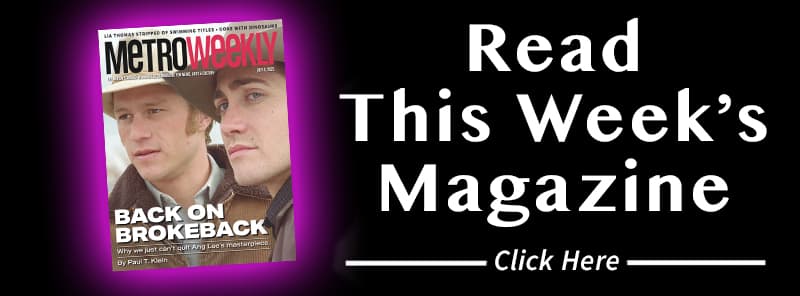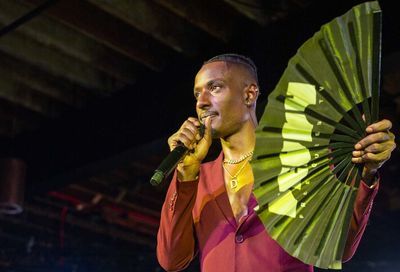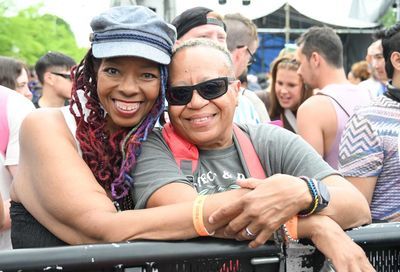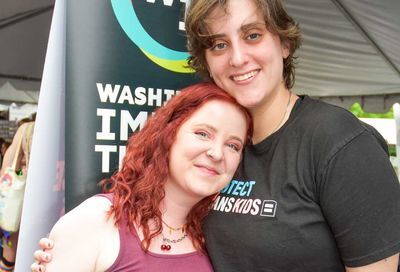Harmonic Convergence
Get ready to please your eyes and ears at Queering Sound
If ”Queering Sound” is distorting, shaking up and subverting familiar sounds — specifically what one might describe as ”gay music” — then ”Queering Sound 08 [Pix el a tion]” offers the same approach to the visual motifs that accompany the sounds to be heard in the eight installments comprising this year’s show.
”Queering Sound is an alternative to the usual celebrations of GLBT/queer music,” says curator J.S. Adams, who performs with BLK w/ BEAR.
Originally, Adams says, ”the idea of Queering Sound was an audio installation piece and also performance artwork, that basically transcribed the destruction of 12-inch dance records.”
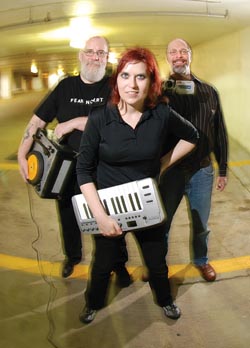
Queering Sound: J.S. Adams, Bev Stanton, Nick Lopata
He says that destruction showed that ”there was so much more in terms of art and music and sound that was coming from the queer community, that wasn’t encapsulated in what was being presented within the culture as a whole.”
In addition to performers from far and wide, this year’s lineup of sound, video and spoken-word artists includes contributions by local artists BLK w/ BEAR, Arthur Loves Plastic, VJ Poppins, Nick Lopata and Dan Vera. They are part of the Triangle Artists Group, an organization of more than 100 GLBT artists from the Baltimore-Washington area.
”The initial one in 1999 was staged as part of an art exhibit by the Triangle Artists Group and entitled ‘Too Queer,”’ Adams recalls. ”It [explored] the idea of, ‘Can something be too queer? Or not queer enough?’ In a way it’s a response to traditional, popular forms of music and art within the GLBT community.”
On the frontline of that response are Adams, Bev Stanton of Arthur Loves Plastic, and Lopata.
Declaration of Electronica
By Yusef Najafi
One of Bev Stanton’s great loves is spinning as a DJ at local parties and clubs. Another is her cat. But while DJing at clubs and cats don’t really go together, Queering Sound is a different story. In this liberating venue, Stanton insists she can get way with just about anything.
”I really feel like I have the freedom to try new things,” says the Silver Spring resident, explaining that a past Queering Sound contribution, a video, featured her feline friend.
”I’ve always felt that I didn’t quite fit into a lot of the fads, so it’s nice to have an arena like this.”
When performing under her band name, Arthur Loves Plastic, Stanton uses a laptop and ”MIDI controllers” –”hardware devices that work with my software so that I don’t have to be so adept with my mouse.”
Software keeps her DJ sets spinning.
”When I do the DJ thing I have a setup that mimics what I would do if I was using vinyl or doing CDs, so it lets me kind of cue things up and go from song to song.”
At Queering Sound [Pix el a tion], Stanton will use software that allows her to play several tracks, including sampled and sequenced material, at the same time, while improvising with a keyboard to add another layer of sound. Most likely, she says, it will be a mash-up of Arthur Loves Plastic material with BLK w/ BEAR, curator J.S. Adams’ group.
”I’ll be taking some pieces that BLK w/ BEAR have done — they have some interesting ambient pieces — and I will just be adding some texture to that.”
While Stanton enhances what audience members hear with her keyboard and computer on stage, group members from BLK w/ BEAR will add to the performance by providing visual elements on a screen behind her.
Stanton has performed at Queering Sound events in years past — she first got involved when Adams asked her to come on board. She describes the annual conclave as ”a showcase of LGBT artists” and ”an audio-visual extravaganza in a comfortable concert setting.”
”It gives me a different avenue of expression, because as a DJ you have to have a certain shtick where you keep people on the dance floor or contribute to an atmosphere, where with Queering Sound you can be more self-directed and do your own thing.”
Recharging that artistically independent sensibility at Queering Sound translates to her unique sound when she spins.
”When you’re an outsider it always kind of really informs your work and in some ways it gives you a lot more freedom,” she says. ”I feel like I don’t have to fit in. It gives you more of an iconoclastic approach.”
That approach has paid off professionally, with Stanton having won several ”Wammie” awards from the Washington Area Music Association, including one in 2007 for ”electronica recording” with her album, Beneath the Watchful Eyes.
And though locals may be familiar with Arthur Loves Plastic’s collaborations with Lisa Moscatiello, Stanton’s artistry remains indie, even if it took years of performing bass guitar in rock bands.
”After a while, all the bands had broken up so I started doing the electronic thing because I could do it by myself, yet collaborate with other people. And I’ve been doing that for the past seven years.”
Art from Scratch
by Yusef Najafi
J.S. Adams has been scratching records since he was a kid growing up in Gary, Ind.
”We used to take lead weights from my father’s workshop and place them on records and run them,” Adams, curator of the annual Queering Sound event, says.
Exploring another side of gay anthems by scratching vinyl records, skewing sounds, looping hypnotic verses and introducing echoes, sort of describes what Adams does when performing with BLK w/ BEAR. He calls it ”audio art.”
”Initially BLK w/ BEAR was a solo effort for me. Then I brought in other folks.” The current lineup is local cello player Doug Poplin; and PD Sexton, who performs on the bass guitar with the group, and is a ”multi-instrumentalist” from Athens, Ga.
Together they create ”temporal turntable installations and laptop compositions utilizing [a] forced-looping technique of altered vinyl recordings and medial decay, along with manipulated voice synthesis and deconstructive ‘turntablism.”’
In simpler terms, it’s taking a familiar song, speeding or slowing the tempo, scratching it up, and mixing it with something obscure until the familiar has become an entirely new creation.
”I’ve always been confrontational to the idea that everybody has to fit inside of one box,” Adams says. ”You can move outside of it, and you don’t have to be limited as to, ‘This is what gay culture is.”’
Adams himself moved outside of the box when coming up with the group’s oddly abbreviated moniker.
”I was in a band back in the early ’80s — kind of a post-punk noise, improvisational, collective band — and we would just do these scurrilous parlor games, to set up lyrics sometimes by just randomly taking phrases from magazine articles and combining them.
”We started throwing out the names of objects, nouns and adjectives, like ‘green with table,’ ‘purple with rubber band’ and then ‘black with bear.’ And it just kind of stuck. It was in a very strange way a precursor to all the bear-community stuff.”
Before BLK w/ BEAR, Adams, who currently works as a computer informational specialist and lives in Washington with his partner, collaborated with other musicians experimenting with electronic music while attending college in Muncie, Ind.
”After college I graduated and moved down to an alternative photo-school in Louisville, Ky., and that’s kind of around the time that punk came out and tore down the boundaries of what was going to be acceptable music and art and presentation.”
With Queering Sound, Adams is doing his part to tear down audio and visual boundaries. He started preparing this year’s lineup in January.
”I sit down and think, ‘What’s the concept? What’s the idea that I want to use as the focal point that some of us can latch onto and others can circle around?”’
This year, the three-hour show will focus on ”pixelation,” the effect caused by zooming in on a section of an image or video. The emphasis is that, says Adams, ”We are all a part of the pixel nation.”
”Because of my background in cinema, I kind of view the show as a continuum from start to finish: just by where I place [artists] and where I put videos, as well as the quality of music, where it may build to a crescendo, kind of mellow out a little bit, then come back.”
The show is also driven by artistic collaborations, he says. The live performers and digital contributors will all be working with each other’s art.
The collaborative vibe has been apparent since the first official Queering Sound event in 2001, when the audience became a part of the show, Adams says.
”We used Donna Summers’ ‘Last Dance,’ and also Indeep’s ‘Last Night a DJ Saved My Life,’ to do an audience sing-along. We published all the lyrics, but then we used an instrumental version of a song that people are not particularly knowledgeable of.”
He adds that the dance record was slowed down and played on multiple turntables.
”It was like, ‘Here are the lyrics, sing along.’ And everybody’s kind of like, ‘How can we sing along?’, because it was kind of a disoriented, playful, sometimes meaningful combination of the two. Finally someone was like, enough is enough and they just started screaming out the lyrics.”
Moments like those are what Adams highlights when explaining how Queering Sound is different from any other GLBT-related music event.
”It’s exposure to new avenues of expression within the GLBT community that are not quite the norm.”
Light and Magic
By Will O’Bryan
Imagine a night at Blowoff, the audio-visual bouquet that recreates itself monthly at the 9:30 Club, attracting a cross-section of gay fellahs and a smattering of other demographics. Local musicians Rich Morel and Bob Mould fill the cavernous space with their collaborative sounds that have become the soundtrack to metro D.C.’s bear crowd and beyond. Creating a focal point in this otherwise dimly lit venue of sweaty, shirtless men, is the screen. Above Morel and Mould, there is imagery. It may be militaristic or magical, looping or lengthy. The wizard behind this particular curtain of imagery is Nick Lopata. But unlike many magic-making wizards, Lopata is all modesty.
”I don’t really think of myself as an artist,” says Lopata, adding that real estate and bartending contribute the lion’s share of his income. ”I think of an artist as someone starting with a blank canvas and creating. Mostly what I’ve done lately is take imagery and mix it up. I took one basic video class in college. It was the year I left school and started managing a restaurant. I never declared a major. Looking back, I was interested in film, video, stage…. But I didn’t see that as practical. I sort of floundered for a while.
”I’m always thrilled when the word ‘artist’ is used for me. I just feel like I’m not there yet. But I’d love to work in film, video, stage, photography….”
When passion is present, it’s difficult to ignore. And Lopata’s work is clearly an expression of the passion that fuels his self-taught voyage through imagery, movement and light. That’s not to say that a bit of kismet along the way hasn’t helped propel Lopata’s discovery of his talent. Fate brought him Morel, both as an artistic collaborator and romantic partner; and Morel gave him an outlet.
”Rich gave me a lot of encouragement. I spent a lot of time taking pictures of Richard and his band, and some video.”
That involvement with the band evolved into Lopata’s turn at lighting the band’s stage. With Christmas lights, disco balls and more, Lopata says he went completely over the top, setting a stage that demanded three hours of preparation for a 45-minute set.
”It was one of the most over-the-top, glam shows,” he says with a laugh. ”It looked great. I’m a huge lighting fan.”
For the work that many have seen at Blowoff, another happy twist of fate is Lopata’s local residence, giving him easy access to the National Archives, which have proven an invaluable source of video clips – everything from basic propaganda to syphilis warnings targeting America’s WWII fighting force.
For Queering Sound 2008, his third year participating, Lopata will be adding imagery to music by Mansard, and Long Division with Remainders. It’s a little early to be asking about just what, exactly, he’s crafted, though. Lopata may be passionate, but that’s no reason to be ploddingly deliberate with his work.
”I am horrible about being ready way ahead of time,” he readily admits. ”I work best when I’m pushed into a corner. I thrive in that environment.”
And he thrives in the Queering Sound environment.
”I’d love for people to come to Queering Sound and see not only my work, but Queering Sound as a whole. It’s one of those things where you’ll find something you’ll like, probably by someone you’ve never heard of before, especially if you have an interest in alternative film and audio. It sort of spans the range – pop to industrial. It’s got a really cool mix, mostly gay artists. I’ve been thrilled to be included.”
Queering Sound 08 [Pix el a tion] happens Saturday, June 7, at 8 p.m. at Warehouse Second Stage, 1021 Seventh St. NW. Tickets are $10, available at the door. For more information, visit members.iglou.com/artbear/queeringsound08.html.
Support Metro Weekly’s Journalism
These are challenging times for news organizations. And yet it’s crucial we stay active and provide vital resources and information to both our local readers and the world. So won’t you please take a moment and consider supporting Metro Weekly with a membership? For as little as $5 a month, you can help ensure Metro Weekly magazine and MetroWeekly.com remain free, viable resources as we provide the best, most diverse, culturally-resonant LGBTQ coverage in both the D.C. region and around the world. Memberships come with exclusive perks and discounts, your own personal digital delivery of each week’s magazine (and an archive), access to our Member's Lounge when it launches this fall, and exclusive members-only items like Metro Weekly Membership Mugs and Tote Bags! Check out all our membership levels here and please join us today!







